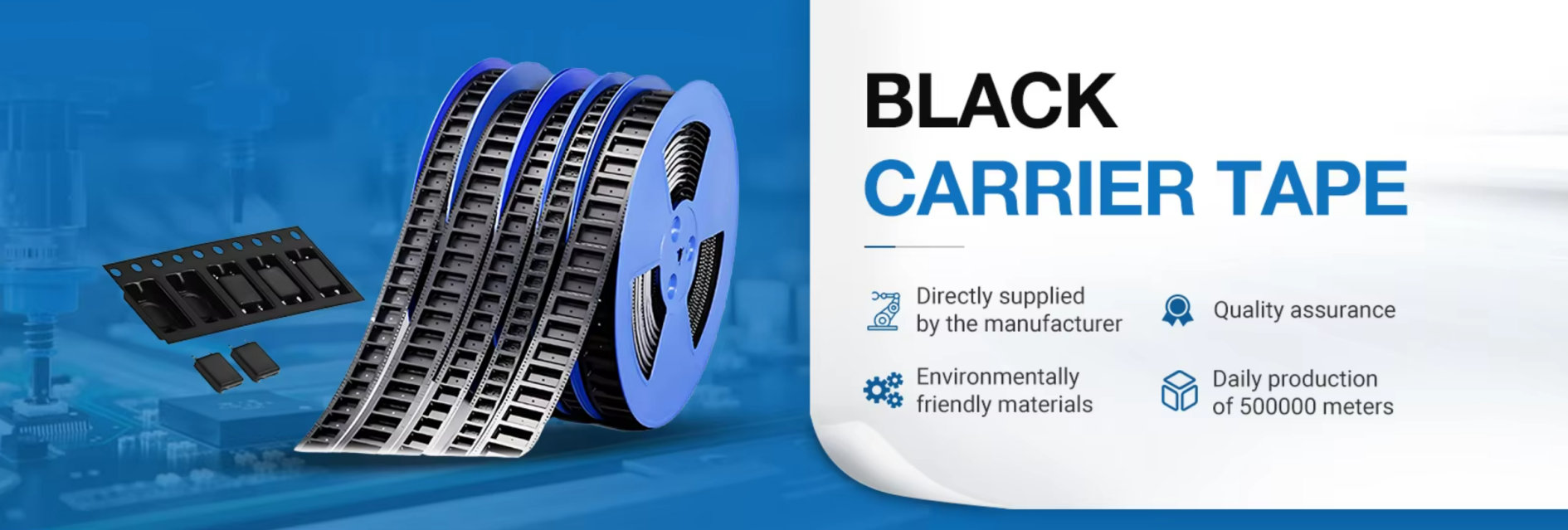Anti-static embossed carrier tape
Time:2024-10-10
Views:323
I.SMD carrier uses anti-static materials: Metals are conductors, and because the leakage current of conductors is large, it can damage devices. Additionally, because insulating materials are prone to electrostatic discharge, they cannot be used as anti-static materials. Instead, materials with surface resistances of less than 1×105Ω·cm, such as so-called electrostatic conductors, and materials with surface resistances of 1×105-1×108Ω·cm, such as electrostatic subconductors, are used as anti-static materials.
For example, common electrostatic protection materials are achieved by mixing conductive carbon black into rubber, with the surface resistance controlled below 1×106Ω·cm.
II. Leakage and Grounding: Ground the areas where static electricity may occur or has occurred to provide a channel for static discharge. Use the method of burying a ground wire to establish an "independent" ground wire.
III. Elimination of Electrostatic Charges on Conductors: Electrostatic charges on conductors can be eliminated by grounding, allowing the charges to leak into the earth. The voltage and discharge time on the discharge can be expressed by the following formula:
UT = U0L1/RC
In this equation, UT represents the voltage at T time (in volts), U0 represents the initial voltage (in volts), R represents the equivalent resistance (in ohms), and C represents the equivalent capacitance of the conductor (in pf).
It is generally required to discharge static within 1 second. That is, the voltage must be reduced to a safe area of less than 100V within 1 second.
This can prevent the SSD from being damaged by the high leakage current and rapid leakage of charge. If U0 = 500V, C = 200pf, and we want UT to reach 100V in 1 second, we require R = 1.28×109Ω. Therefore, a 1MΩ limiting resistor is commonly used in ESD protection systems to limit the discharge current to less than 5mA.SMD carrier uses anti-static materials: Metals are conductors, and because the leakage current of conductors is large, it can damage devices. Additionally, because insulating materials are prone to electrostatic discharge, they cannot be used as anti-static materials. Instead, materials with surface resistances of less than 1×105Ω·cm, such as so-called electrostatic conductors, and materials with surface resistances of 1×105-1×108Ω·cm, such as electrostatic subconductors, are used as anti-static materials.

For example, common electrostatic protection materials are achieved by mixing conductive carbon black into rubber, with the surface resistance controlled below 1×106Ω·cm.
II. Leakage and Grounding: Ground the areas where static electricity may occur or has occurred to provide a channel for static discharge. Use the method of burying a ground wire to establish an "independent" ground wire.
III. Elimination of Electrostatic Charges on Conductors: Electrostatic charges on conductors can be eliminated by grounding, allowing the charges to leak into the earth. The voltage and discharge time on the discharge body can be expressed by the following formula:
UT = U0L1/RC
In this equation, UT represents the voltage at T time (in volts), U0 represents the initial voltage (in volts), R represents the equivalent resistance (in ohms), and C represents the equivalent capacitance of the conductor (in pf).
It is generally required to discharge static within 1 second. That is, the voltage must be reduced to a safe area of less than 100V within 1 second.
This can prevent the SSD from being damaged by the high leakage current and rapid leakage of charge. If U0 = 500V, C = 200pf, and we want UT to reach 100V in 1 second, we require R = 1.28×109Ω. Therefore, a 1MΩ limiting resistor is commonly used in ESD protection systems to limit the discharge current to less than 5mA.














